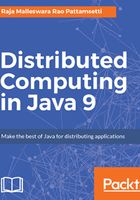
Design considerations for distributed systems
Following are some of the characteristics of distributed systems that should be considered in designing a project in a distributed environment:
No global clock: Being distributed across the world, distributed systems cannot be expected to have a common clock, and this gives a chance for the intrinsic asynchrony between the processors performing the computing. Distributed system coordination usually depends on a shared idea of the time at which the programs or business state occurs. However, with distributed systems, having no global clock, it is a challenge to attain the accuracy with which the computers in the network can synchronize their clocks to reflect the time at which the expected program execution happened. This limitation expects the systems in the network to communicate through messages instead of time-based events.
Geographical distribution: The individual systems taking a part in distributed system are expected to be connected through a network, previously through a Wide-Area Network (WAN), and now with a Network Of Workstations/Cluster Of Workstations (NOW/COW). An in-house distributed system is expected to be configured within a LAN connectivity. NOW is becoming widespread in the market with its low-cost, high-speed, off-the-shelf processing capability. Most popular NOW architectures include the Google search engine, Amazon.
No shared memory: An important and key feature of distributed computing and the message-passing model of communication is having no shared memory, which also infers the nonexistence of a common physical clock.
Independence and heterogeneity: The distributed system processors are loosely coupled so that they have their own individual capabilities in terms of speed and method of execution with versatile operating systems. They are not expected to be part of a dedicated system; however, they cooperate with one another by exposing the services and/or executing the tasks together as subtasks.
Fail-over mechanism: We often see computer systems failing, and it is the design responsibility of setting the expected behavior with the consequence of possible failures. Distributed systems are observed to be failed in integration as well as the individual sub systems. A fault in the network can result in the isolation of an individual or a group of computers in the distributed system; however, they might still be executing the programs they are expected to execute. In reality, the individual programs may not be able to detect such network failures or timeouts. Similarly, the failure of a particular computer, a system being terminated abruptly with an abrupt program or system failure, may not immediately be known by the other systems/components in the network with which the failed computer usually communicates with. The consequences of this characteristic of distributed systems has to be captured in the system design.
Security concerns: Distributed systems being set up on a shared Internet are prone to more unauthorized attacks and vulnerabilities.
Distributed systems are becoming increasingly popular with their ability to allow the polling of resources, including CPU cycles, data storage, devices and services becoming increasingly economical. Distributed systems are more reliable as they allow replication of resources and services, which reduces service outages due to individual system failures. Cost, speed, and availability of Internet are making it a decent platform on which to maintain distributed systems.